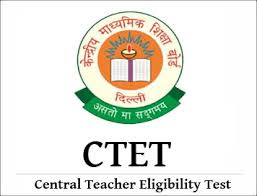CTET Exam Pattern
Central Board of Secondary Education has authority to operate central
teacher eligibility test. Hey friends to get
success in central
teacher eligibility test, make preparation according
to CTET Exam Pattern. Dear job seekers now all of you may
downward CTET Paper I / II Pattern same as PDF file from this article.
All candidates will eligible to be a teacher in Primary school
(Class I to V) and Upper Primary school (Class VI to VIII) who will able to
crack this exam. To crack central teacher eligibility test you need to make
preparation well with actual details given on this web page. Each and every
applicant is suggested to stay tuned with us for latest information of central
teacher eligibility test.
Overall highlights
related to central teacher eligibility test / exam pattern are published below
for all the visitors of this web page. Concentration and management is
necessary to do better in exam. All the best for good result in central teacher
eligibility test.
ctet.nic.in Exam Pattern All the Details
CTET
Exam Pattern
CTET Paper I Exam Pattern
- The CTET Paper will be bilingual i.e English and Hindi.
- The exam will contain 150 MCQ type questions and each question carries 1 marks.
- The duration of exam is of 2.30 hours.
- There will be no negative marking.
- Questions will be based on prescribed syllabus of NCERT.
- Candidates can choose any language as Language-I and other as Language-II from the options available in language section which is required to clear at confirmation page.
Exam
Subject
|
No. of
Questions
|
Total
Marks
|
Duration
|
Child
Development and Pedagogy
|
30
|
30
|
150
Minutes (2:30 Hours)
|
Language-I
|
30
|
30
|
|
Language-
II
|
30
|
30
|
|
Mathematics
|
30
|
30
|
|
Environmental
Studies
|
30
|
30
|
|
Total
|
150
|
150
|
CTET Paper II Exam Pattern
- The CTET Questions Paper will contain 150 objective type questions and each question will carry one mark.
- The Paper will be bilingual i.e English and Hindi.
- The duration of Paper-II is of 2.30 hours.
- No negative marking is applicable in the exam.
- Questions will be based on prescribed syllabus of NCERT for Class VI to class VIII but difficulty level will be as per 12th
Exam
Subject
|
No. of
Questions
|
Total
Marks
|
Duration
|
Child
Development and Pedagogy
|
30
|
30
|
150
Minutes (2:30 Hours)
|
Language-I
|
30
|
30
|
|
Language-
II
|
30
|
30
|
|
Mathematics
and Science
|
30
|
30
|
|
Social
Studies/ Social Science
|
30
|
30
|
|
Total
|
150
|
150
|
Important Points
- The Central Teacher Eligibility Test shall apply the Central Govt. schools such as NVS, KVS, Central Tibetan Schools etc. and school under the administrative control of Union Territory.
- Central Teacher Eligibility Test qualifying certificate will be valid for sever year from date of issuance of the certificate.
- Candidates may attempt CTET any number of times for obtaining CTET Certificate.
- A CTET qualified person can appear again for improving his/her CTET score.
- The CTET Exam Centre once permitted cannot be changed under any situation.
CTET Exam Syllabus
Paper I
(for classes I to V) Primary Stage
Child Development and Pedagogy
Child Development and Pedagogy
Child Development (Primary School Child)
Concept of Inclusive education and understanding
children with special needs
Learning and Pedagogy
Language I:
Language Comprehension
Pedagogy of Language Development
Language- II:
Comprehension
Two unseen prose passages
Pedagogy of Language Development
Mathematics:
Geometry
Shapes & Spatial Understanding
Solids around Us
Numbers
Addition and Subtraction
Multiplication
Division
Measurement
Weight, Time
Volume, Data Handling
Patterns, Money
Environmental Studies:
Family and Friends
Food
Shelter
Water
Travel
Things We Make and Do
Paper
II (for classes VI to VIII) Elementary Stage
Child Development and Pedagogy
Child Development and Pedagogy
Child Development (Primary School Child)
Concept of Inclusive education and understanding children with
special needs
Learning and Pedagogy
Language I and Language II and Mathematics: Same
As Above
Science:
Food, Materials
The World of the Living
How things work
Natural Phenomena
Natural Resources
Social Studies/ Social Science:
History:
When, Where and How
The Earliest Societies
The First Farmers and Herders
The First Cities
Early States
New Ideas
The First Empire
Contacts with Distant lands
Political Developments
Culture and Science
New Kings and Kingdoms
Sultans of Delhi
Architecture
Creation of an Empire
Social Change
Regional Cultures
The Establishment of Company Power
Rural Life and Society
Colonialism and Tribal Societies
The Revolt of 1857-58
Women and reform
Challenging the Caste System
Geography:
Geography as a social study and as a science
Planet: Earth in the solar system
Globe, Environment in its totality: natural and human
environment
Air, Water
Human Environment: settlement, transport and
communication
Resources: Types-Natural and Human
Agriculture.
Social and Political Life:
Diversity
Government
Local Government
Making a Living
Democracy
State Government
Understanding Media
Unpacking Gender
The Constitution
Parliamentary Government
The Judiciary
Social Justice and the Marginalised
Take a Look on Below Table




0 comments:
Post a Comment